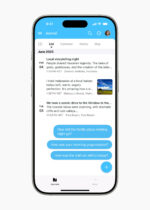The next generation of the Windows phone platform is numbered 7.1 and code-named Mango. A .1 release is positioned as a minor maintenance release, but with 500 improvements, someone at Microsoft must have missed a meeting. Perhaps this is to lull Apple and Google into a false sense of security, but Mango looks to deliver a bowl of fruit-flavored whoop-ass when it arrives later this year.
Confessions of a Windows Phone 7 user
I’m a loyal Windows Phone 7 user, and that is largely because this phone, unlike so many other so-called smartphones, is actually a good phone. It is a rolling joke that the iPhone, while great at a number of things, actually sucks at being a phone. It is basically a very good iPod with phone features, and it shows. It even has some crazy features like FaceTime, which is a video conferencing application that only works with other Apple products. What don’t people get about communications applications having to interoperate across vendors?
In any case, Windows Phone 7 devices were initially optimized for applications like the Kindle reader and Netflix player. The user interface is simple and taking a picture simply requires you to unlock the phone and hit the camera button. No hunting and searching for a camera application while whatever you wanted to shoot disappears from view. It doesn’t have all the apps that either an iPhone or Android phone has, but it has the ones I want on a phone and I can get to them quickly.
My favorite is the Dell Venue Pro, which has an honest-to-goodness keyboard placed vertically so you can text like we used to on a BlackBerry. In short, I haven’t found anything I like better, but the next version makes this one look out of date.
The Apple crushing Mango
OK, I know I’m pushing it and the Windows Phone platform lines up against Android better, anyway. So the next version gets full IE9 support, Silverlight and integrated social networking features. Once in an application, you can leap to related applications to get stuff done without jumping all the way out to the home screen. But the big parts are Nokia and Skype.
We often forget that Nokia is the biggest cell phone company in the world and Skype is the biggest Voice Over IP (VOIP) provider. Nokia is coming out with a line of Mango phones, and they have a design capability that rivals Apple. Skype, built into Mango phones, should allow them (if the carriers don’t screw it up) to use VOIP to significantly and automatically cut call costs dramatically particularly long-distance calls. This could be huge for anyone who has relatives or business contacts overseas.
Nokia is strong where Apple is weak: Europe and Asia. And the carriers are weaker there as well. This means the combination could have enough advantages to give Apple a run for its money and overwhelm Google, unless Google significantly ups its game.
Long time till Mango
Unfortunately, the Nokia Mango phones aren’t due until at least November, and the iPhone 5 and next-generation Android phones should be hitting about the same time. And I doubt either Google or Apple is going to let Microsoft get this kind of a lead unchallenged. Still, this is an impressive platform and I’m dying to see what Nokia comes up with in terms of hardware.
In the end though, all three vendors are pushing each other pretty hard, which suggests the speed of advancement going forward is going to be incredible. I’m thinking it is time to switch from two-year to one-year contracts from now on.
The way things are going, these smartphones will become the backbone of Skynet, and we’ll need John Connor to save us again. I want to be on Skynet’s good side when that happens because I’ve seen “The Terminator” movies and I sure as hell don’t want to be on its bad side.
Rob Enderle is a principal analyst at the Enderle Group.






